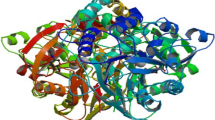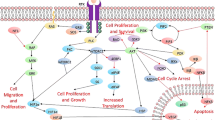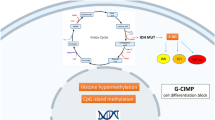Abstract
Purpose
Glioblastoma multiforme (GBM) is the most lethal primary brain tumor in adults. The epigenetically active ribonucleoside analog 5-azacitidine is a new therapy option that changes tumor cell chromatin, which is frequently modified by methylation and deacetylation in malignant gliomas.
Methods
In vitro, we analyzed cell viability, cell apoptosis, and migration of human GBM cells. In vivo, we established subcutaneous and intracerebral GBM mouse models originating from U87MG, U373MG, and primary GBM cells as well as one patient-derived xenograft. Xenografts were treated with 5-azacitidine as well as valproic acid, bevacizumab, temozolomide, and phosphate buffered saline. The tumor sizes and Ki67 proliferation indices were determined. Glioma angiogenesis was examined immunohistochemically by expression analysis of endothelial cells (CD31) and pericytes (PDGFRβ).
Results
In vitro, 5-azacitidine treatment significantly reduced human glioblastoma cell viability, increased cellular apoptosis, and reduced cellular migration. In vivo, 5-azacitidine significantly reduced growth in two intracerebral GBM models. Notably, this was also shown for a xenograft established from a patient surgery sample; whereas, epigenetically acting valproic acid did not show any growth reduction. Highly vascularized tumors responded to treatment, whereas low-vascularized xenografts showed no response. Furthermore, intracerebral glioblastomas treated with 5-azacitidine showed a clearly visible reduction of tumor angiogenesis and lower numbers of endothelial cells and tumor vessel pericytes.
Conclusions
Our data show significant growth inhibition as well as antiangiogenic effects in intracerebral as well as patient-derived GBM xenografts. This encourages to investigate in detail the multifactorial effects of 5-azacitidine on glioblastomas.





Similar content being viewed by others
References
(2008) Comprehensive genomic characterization defines human glioblastoma genes and core pathways. Nature 455(7216):1061–1068
Amatya VJ, Naumann U, Weller M, Ohgaki H (2005) TP53 promoter methylation in human gliomas. Acta Neuropathol 110(2):178–184
Arrillaga-Romany I, Reardon DA, Wen PY (2014) Current status of antiangiogenic therapies for glioblastomas. Expert Opin Investig Drugs 23(2):199–210
Baeza N, Weller M, Yonekawa Y, Kleihues P, Ohgaki H (2003) PTEN methylation and expression in glioblastomas. Acta Neuropathol 106(5):479–485
Caren H, Pollard SM, Beck S (2013) The good, the bad and the ugly: epigenetic mechanisms in glioblastoma. Mol Aspects Med 34(4):849–862
Clarke J, Penas C, Pastori C, Komotar RJ, Bregy A, Shah AH, Wahlestedt C, Ayad NG (2013) Epigenetic pathways and glioblastoma treatment. Epigenetics 8(8):785–795
Comprehensive IG (2015) Analysis of diffuse lower-grade gliomas. N Engl J Med
Creusot F, Acs G, Christman JK (1982) Inhibition of DNA methyltransferase and induction of friend erythroleukemia cell differentiation by 5-azacytidine and 5-aza-2′-deoxycytidine. J Biol Chem 257(4):2041–2048
Day RS 3rd, Ziolkowski CH, Scudiero DA et al (1980) Defective repair of alkylated DNA by human tumour and SV40-transformed human cell strains. Nature 288(5792):724–727
Duenas-Gonzalez A, Candelaria M, Perez-Plascencia C, Perez-Cardenas E, de la Cruz-Hernandez E, Herrera LA (2008) Valproic acid as epigenetic cancer drug: preclinical, clinical and transcriptional effects on solid tumors. Cancer Treatm Rev 34(3):206–222
Etcheverry A, Aubry M, de Tayrac M et al (2010) DNA methylation in glioblastoma: impact on gene expression and clinical outcome. BMC Genom 11:701
Giese A, Bjerkvig R, Berens ME, Westphal M (2003) Cost of migration: invasion of malignant gliomas and implications for treatment. J Clin Oncol 21(8):1624–1636
Gottlicher M, Minucci S, Zhu P et al (2001) Valproic acid defines a novel class of HDAC inhibitors inducing differentiation of transformed cells. EMBO J 20(24):6969–6978
Hegi ME, Diserens AC, Gorlia T et al (2005) MGMT gene silencing and benefit from temozolomide in glioblastoma. N Engl J Med 352(10):997–1003
Issa JP, Kantarjian HM (2009) Targeting DNA methylation. Clin Cancer Res 15(12):3938–3946
Jones PA, Baylin SB (2002) The fundamental role of epigenetic events in cancer. Nat Rev Genet 3(6):415–428
Jones PA, Taylor SM (1980) Cellular differentiation, cytidine analogs and DNA methylation. Cell 20(1):85–93
Kleihues P, Soylemezoglu F, Schauble B, Scheithauer BW, Burger PC (1995) Histopathology, classification, and grading of gliomas. Glia 15(3):211–221
Kouzarides T (2007) Chromatin modifications and their function. Cell 128(4):693–705
Lander ES, Linton LM, Birren B et al (2001) Initial sequencing and analysis of the human genome. Nature 409(6822):860–921
Martinez R, Martin-Subero JI, Rohde V et al (2009) A microarray-based DNA methylation study of glioblastoma multiforme. Epigenetics 4(4):255–264
Mattson RH, Cramer JA, Collins JF (1992) A comparison of valproate with carbamazepine for the treatment of complex partial seizures and secondarily generalized tonic-clonic seizures in adults. The Department of Veterans Affairs Epilepsy Cooperative Study No. 264 Group. N Engl J Med 327(11):765–771
Natsume A, Kondo Y, Ito M, Motomura K, Wakabayashi T, Yoshida J (2010) Epigenetic aberrations and therapeutic implications in gliomas. Cancer Sci 101(6):1331–1336
Ning X, Shi Z, Liu X et al (2015) DNMT1 and EZH2 mediated methylation silences the microRNA-200b/a/429 gene and promotes tumor progression. Cancer Lett 359(2):198–205
Norden AD, Young GS, Setayesh K et al (2008) Bevacizumab for recurrent malignant gliomas: efficacy, toxicity, and patterns of recurrence. Neurology 70(10):779–787
Ohgaki H, Kleihues P (2005) Epidemiology and etiology of gliomas. Acta Neuropathol 109(1):93–108
Okemoto K, Kasai K, Wagner B et al (2013) DNA demethylating agents synergize with oncolytic HSV1 against malignant gliomas. Clin Cancer Res 19(21):5952–5959
Parsons DW, Jones S, Zhang X et al (2008) An integrated genomic analysis of human glioblastoma multiforme. Science 321(5897):1807–1812
Polivka J Jr, Polivka J, Rohan V, Topolcan O, Ferda J (2012) New molecularly targeted therapies for glioblastoma multiforme. Anticancer Res 32(7):2935–2946
Robertson KD (2005) DNA methylation and human disease. Nat Rev Genet 6(8):597–610
Silverman LR, Demakos EP, Peterson BL et al (2002) Randomized controlled trial of azacitidine in patients with the myelodysplastic syndrome: a study of the cancer and leukemia group B. J Clin Oncol 20(10):2429–2440
Soriano AO, Yang H, Faderl S et al (2007) Safety and clinical activity of the combination of 5-azacytidine, valproic acid, and all-trans retinoic acid in acute myeloid leukemia and myelodysplastic syndrome. Blood 110(7):2302–2308
Stoczynska-Fidelus E, Piaskowski S, Bienkowski M et al (2014) The failure in the stabilization of glioblastoma-derived cell lines: spontaneous in vitro senescence as the main culprit. PLoS One 9(1):e87136
Stupp R, Mason WP, van den Bent MJ et al (2005) Radiotherapy plus concomitant and adjuvant temozolomide for glioblastoma. N Engl J Med 352(10):987–996
Stupp R, Hegi ME, Mason WP et al (2009) Effects of radiotherapy with concomitant and adjuvant temozolomide versus radiotherapy alone on survival in glioblastoma in a randomised phase III study: 5-year analysis of the EORTC-NCIC trial. Lancet Oncol 10(5):459–466
Weller M, Gorlia T, Cairncross JG et al (2011) Prolonged survival with valproic acid use in the EORTC/NCIC temozolomide trial for glioblastoma. Neurology 77(12):1156–1164
Weller M, Stupp R, Hegi M, Wick W (2012) Individualized targeted therapy for glioblastoma: fact or fiction? Cancer J 18(1):40–44
Wen PY, Kesari S (2008) Malignant gliomas in adults. N Engl J Med 359(5):492–507
Workman P, Aboagye EO, Balkwill F et al (2010) Guidelines for the welfare and use of animals in cancer research. Br J Cancer 102(11):1555–1577
Yoo CB, Jones PA (2006) Epigenetic therapy of cancer: past, present and future. Nat Rev Drug Discov 5(1):37–50
Acknowledgements
We would like to thank Dr. J. Walter (Department of Neurosurgery; University Hospital of Jena; Jena, Germany) for providing human primary glioblastoma cells. We would also like to thank Margit Lemm and Carsta Werner (MaxDelbrückCenter for Molecular Medicine; Berlin, Germany) for excellent technical assistance.
Funding
No funding received.
Author information
Authors and Affiliations
Corresponding author
Ethics declarations
Conflict of interest
All authors declare that they have no conflicts of interest.
Ethical approval
All applicable international, national, and/or institutional guidelines for the care and use of animals were followed. All procedures performed in studies involving human participants were in accordance with the ethical standards of the institutional and/or national research committee and with the 1964 Helsinki declaration and its later amendments or comparable ethical standards. Informed consent was obtained from all individual participants included in the study.
Additional information
This study is dedicated to Prof. Uwe-Karsten Hanisch.
Electronic supplementary material
Below is the link to the electronic supplementary material.
Suppl. 1
Five-azacitidine elicited no antiangiogenic effects in scanty vascularized CX1 and CX2 GBM xenografts. (A, B) In CX1 GBMs, CD31 labeling revealed no significant reduction of the number of endothelial cells after 5-azacitidine therapy (p > 0.05), in comparison to the antiangiogenic effects of the positive controls bevacizumab and temozolomide (p < 0.001). (C, D) Vascularization was also not significantly affected by 5-azacitidine therapy in CX2 xenografts (p > 0.05), compared to the reduced number in the positive controls bevacizumab (p < 0.001) and temozolomide (p < 0.05), as demonstrated by CD31 labeling. (E) Otherwise, in highly vascularized subcutaneous U87MG GBMs, 5-azacitidine as well as bevacizumab therapy significantly (p < 0.001) reduced the number of CD31 positive endothelial cells. (PPT 651 KB)
Rights and permissions
About this article
Cite this article
Kratzsch, T., Kuhn, S.A., Joedicke, A. et al. Treatment with 5-azacitidine delay growth of glioblastoma xenografts: a potential new treatment approach for glioblastomas. J Cancer Res Clin Oncol 144, 809–819 (2018). https://doi.org/10.1007/s00432-018-2600-1
Received:
Accepted:
Published:
Issue Date:
DOI: https://doi.org/10.1007/s00432-018-2600-1




